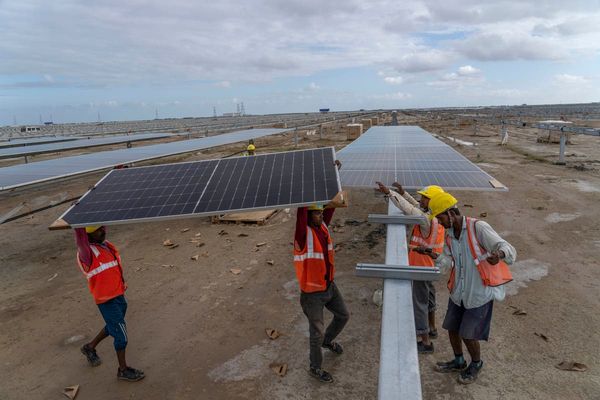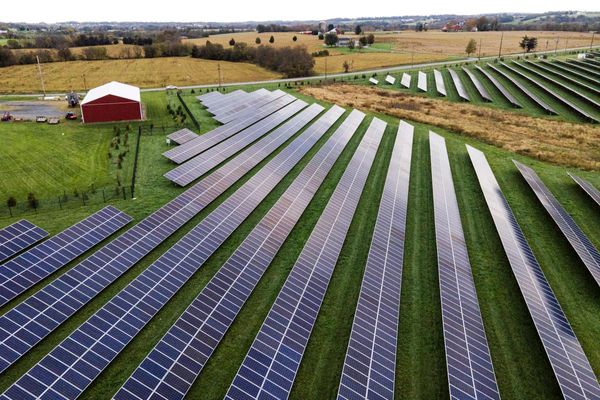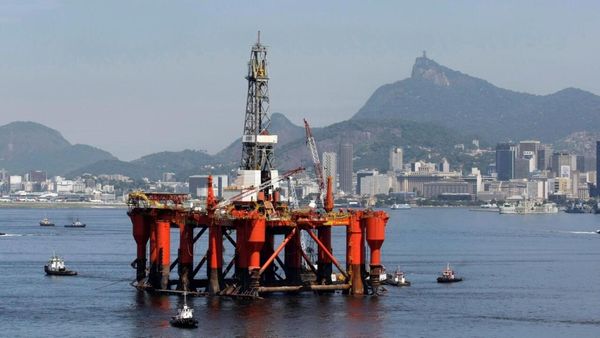
This past summer, as wildfires raged through Canada, killing at least 17 people and burning more than 45.7 million acres — blazes that were made 50% more intense by climate change fueled by the burning of fossil fuels — some Canadians took out their anger on their country’s pension plan. They demanded that the Canadian Pension Plan Investment Board stop investing their retirement savings in a Colorado oil and gas company that’s ramped up its extraction activity in recent years, drilling near homes, schools and parks.
Like many other North American pension systems, the Canadian Pension Plan Investment Board had promised to decarbonize its portfolio by 2050. But it’s also the largest shareholder in Civitas Resources, owning 20% of the Denver energy company’s stock as of April 14, documents filed with the U.S. Securities and Exchange Commission show. Akin to the U.S. Social Security system, about 21 million Canadians must pay into the government-sponsored retirement plan, which manages about $576 billion on their behalf.
“If it were up to me, I would not be investing any of my savings in fossil fuels — none of my private savings is invested in these companies,” said Patrick DeRochie, senior manager for Shift: Action for Pension Wealth and Planet Health, an organization that tracks fossil fuel investments. “The board is undermining the retirement security and safe climate that every working Canadian and every retired Canadian relies on.”
It’s not a household name, but Civitas Resources has quickly become a dominant energy producer in Colorado and one of the fastest growing in the country. In turn, it’s come to exemplify a number of trends in oil and gas — from the growing role of private equity in extending the life of fossil fuels to the adoption of an approach that balances clean energy initiatives with fossil fuel production to better prepare for the inevitable transition to a green economy. The company claims to be the “first carbon-neutral energy producer” in Colorado, which is one of the biggest oil and gas producing states in the country. While its business model has been hailed by Wall Street analysts, its sustainability commitments have been questioned by environmentalists.
Formed in 2021 amid a slew of mergers and acquisitions involving four of Colorado’s top nine oil producers, Civitas has kept growing, and it operated the largest number of wells over the last four years in the state’s largest oil and gas basin.
Uncertainty about the fossil fuel industry’s future amid a warming climate — attributed chiefly to carbon dioxide and methane emissions from combustion of its products — is forcing companies like Civitas to obtain financing from less risk-averse institutional investors like public pensions and private equity.
Its ownership structure stands out from traditional producers for its unusual mix – a Canadian pension plan (20% stake), private equity firm (Kimmeridge Energy Management Company LLC (14.5%), asset management behemoths BlackRock Inc. (11.7%) and the Vanguard Group (10.6%) and financial services giant Fidelity Investments (6.6%), a Capital & Main review of federal filings found.
Rising Demand, Bigger Deals, Less Robust Sustainability Plans
Private equity is known for prioritizing high rates of return and exiting investments quickly, and its increasing role in financing fossil fuel production in Colorado and around the country is raising concerns among environmentalists who question its claims to be reducing emissions.
These firms in part funded a flurry of merger and acquisition activity in the industry since 2019, as companies sought out untapped hydrocarbons to meet rising demand for energy. Deal value in 2021 hit $192 billion, far exceeding the figures for 2015, 2016, 2018 and 2020, with many wells shifting from publicly traded companies with emissions reduction commitments to private firms with less robust sustainability plans, according to an analysis by the Environmental Defense Fund.
Civitas and another big private equity-owned Colorado producer, Caerus Oil and Gas, have been criticized for not properly accounting for their emissions of carbon and methane.
Recently, the asset shuffle in the industry has intensified as the U.S. solidified its lead as the world’s largest oil and gas supplier, with production hitting 12 billion barrels a day in 2022, outpacing Saudi Arabia and Russia. Meanwhile, scientists warn such hydrocarbons must remain underground to limit the global temperature increase to 1.5 degrees Celsius (2.7 degrees Fahrenheit) — warming that they say will lead to more intense fires, floods and drought. The window is narrowing.
“Investors are taking a bet that the oil and gas business has more legs in it than might have been thought during the pandemic.”~ Brad Handler, Colorado School of Mines
Global temperatures will rise to 3 C if countries don’t institute sharp reductions in greenhouse gas emissions, according to a Nov. 20 United Nations Emissions Gap report. In a second document researchers asserted that worldwide fossil fuel production is on track to be more than twice that needed to limit warming to 1.5 C.
Colorado is among the top five crude-oil producing states, supplying about 4% of the country’s production in 2022. It’s also been at the center of some of the industry’s most scrutinized deals in which private equity and institutional investors bought bankrupt firms, giving new life to thousands of oil and gas wells.
“Private equity reemerged as a force within smaller oil and gas companies coming out of COVID,” said Brad Handler, program manager for the Sustainable Finance Lab at the Colorado School of Mines. “Investors are taking a bet that the oil and gas business has more legs in it than might have been thought during the pandemic.”
Indeed, Civitas Resources rolled up Bonanza Creek, HighPoint Resources, Extraction Oil & Gas and Crestone Peak Resources in November 2021 in a bid to combine acreage to drive down costs in the Denver-Julesburg basin, the state’s largest oil play.
Civitas bills itself as Colorado’s “first carbon-neutral oil & gas company.” The Denver-based firm published a 2022 sustainability report that said it sought to reduce emissions by relying on electric drilling equipment and transporting oil and water by pipeline, instead of truck, “when feasible.”
The company, however, is focused on reducing what is known as scope one and scope two greenhouse gas emissions emitted by its equipment and operations. Its efforts don’t include scope three emissions, which result from the burning of its product in vehicles and industrial operations, documents show. Omitting scope three emissions renders its sustainability plan essentially moot, experts said.
“Scope one and two emissions account for only 15% of upstream oil and gas emissions,” said Maeve O’Connor, an oil and gas analyst at Carbon Tracker, an independent financial think tank. “Such a target could be seen as near useless.”
Industry analysts note that even though Civitas is largely held by institutional investors, it is also a public company that is accountable to shareholders.
The company’s sustainability report also said the firm retrofitted its natural gas operations with controllers that limit methane emissions and focused on leak detection and repair.
Yet Civitas is listed as the eighth largest methane emitter by basin in 2021, according to a May 2023 report by Ceres, a sustainability focused nonprofit, and the Clean Air Task Force.
The analysis found that private equity backed 60% of the top 10 such companies by basin. Methane is 80 times more potent than carbon dioxide in trapping heat in the atmosphere in the first 20 years after it’s emitted.
Civitas and Kimmeridge didn’t return multiple phone calls and emails seeking comment for this story.
Industry analysts noted that even though Civitas is largely held by institutional investors, it is also a public company that is accountable to shareholders who can buy and sell its stock on public markets.
“Yes, the development of the resource is being held in a lot fewer hands,” said Lloyd Byrne, an analyst at Jefferies. “But taking these companies and pulling them into Civitas is a net positive for Colorado — they are putting assets in the hands of producers who are responsible and also held to a higher standard by the public market.”
Caerus Oil and Gas is another Colorado-based producer that touts its sustainability efforts but has been ranked as the largest methane emitter by basin in the Ceres and the Clean Air Task Force study. The company, which largely operates on the Western slope of the Rocky Mountains in the gas-rich Piceance basin, emitted about 62 million tons of methane in 2021, the groups found.
The Denver-based concern, named for the Greek god of opportunity, was created by investment firms Oaktree Capital Management and Anschutz Investment Company in 2009.
“The claim that they are producing fossil fuels in a sustainable way is really essential to getting funding from pension funds and investors.”~ Alan Zibel, Public Citizen
Caerus is “working to set emissions reductions targets, in particular with regard to methane and CO2e” (or the number of metric tons of carbon dioxide emissions), according to its 2022 sustainability report. The company operates more than 7,500 wells in Colorado and eastern Utah and holds “over 10,000 future drilling locations,” the document shows.
Canada-based private equity giant Brookfield Corporation, which called itself a “leader in decarbonization,” acquired a majority stake in Oaktree in 2019. Like Civitas, however, Brookfield does not properly account for emissions that result from the end use of its products, researchers found in a December analysis.
“Major private equity firms like Brookfield can undercount their emissions and undermine their own commitments since they face less public pressure and regulatory oversight than other financial institutions such as banks, allowing them to greenwash their operations while doubling-down on fossil fuel assets,” wrote analysts at Americans for Financial Reform Education Fund, Global Energy Monitor and the Private Equity Stakeholder Project.
Brookfield did not return a request for comment.
The ‘Green Halo’ Effect
Private equity also supports a vast amount of oil and gas production on public lands, with such drillers comprising 78% approved federal drilling permits since 2017 in Colorado alone. The state could face the nation’s largest cleanup costs for such operations, totaling $161.2 million, researchers at the Private Equity Stakeholder Project and Public Citizen found in an August report.
Claims that their fossil fuel operations are sustainable are pivotal to the business model of these concerns as they consolidate assets across high producing oil and gas basins, said Alan Zibel, a researcher at Public Citizen, a consumer advocacy nonprofit.
“The claim that they are producing fossil fuels in a sustainable way is really essential to getting funding from pension funds and investors,” he said. “It’s a common strategy to base everything in a green halo.”
As Canadian fires raged and sent smoke across much of the U.S. last summer, Civitas announced plans to increase oil and gas production by 60%.
The exchange of assets between oil and gas companies is unlikely to end soon, as companies vie for what remains of vast underground fossil fuel deposits in Colorado and elsewhere.
Private equity investment in such deals fell in 2023, with only 10 new exploration and production investments, compared to 100 per year in the last decade, according to a July report from Enverus Intelligence Research. One major exception was Civitas, which was a major player in deals that did play out.
As Canadian fires raged and sent smoke across much of the U.S., Civitas announced plans to increase production by 60% with a $4.7 billion purchase of shale assets in New Mexico and Texas held by portfolio companies managed by private equity firm NGP Energy Capital Management LLC.
Blazes continued to burn in October, when the company announced a $2.1 billion deal to purchase more acreage in Texas’ oil-rich Permian Basin from Vencer Energy, a venture created in 2020 by global energy trader Vitol. The acquisition added 400 locations to the firm’s portfolio.
The transactions split the firm’s assets between Colorado’s Denver-Julesburg Basin and the Midland and Delaware basins — the nation’s three lowest break-even shale plays. In a conference call previewing the October deal, company executives talked up how the pair of deals would allow Civitas to produce oil and gas for the next decade and spin off billions of dollars for investors.
“We expect to generate $1.8 billion in free cash flow next year assuming $80 oil and $3.50 gas,” said Civitas CEO Chris Doyle on the call. “This will further enhance our industry leading shareholder program, which has delivered $1.3 billion to shareholders since early last year.”










